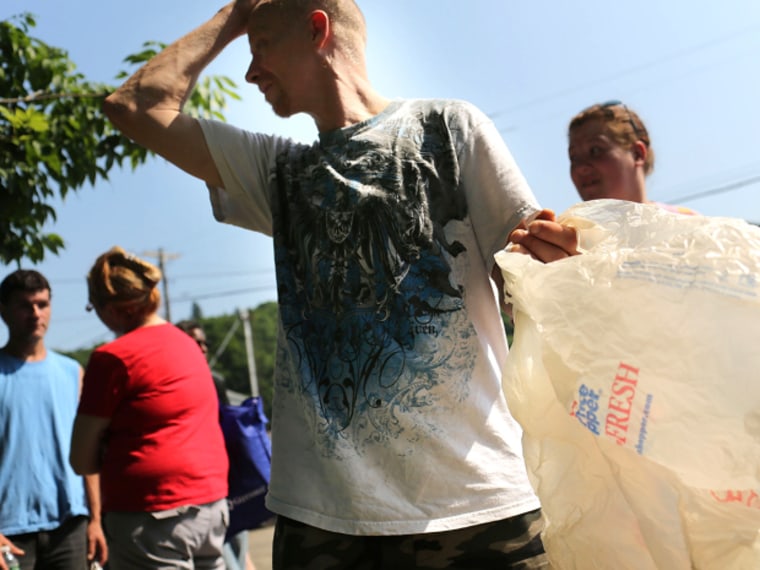As House Speaker John Boehner, R-Ohio, squares off against the White House in Washington, his own state’s food banks are feeling the consequences. Thanks to the government shutdown, Ohio Association of Foodbanks (OASHF) has been left fighting to stay afloat without the Department of Agriculture funds it relies on to cover basic administrative costs.
“We expect that if and when funding is applied through a continuing resolution, it will be applied retroactively,” said OASHF Lisa Hamler-Fugitt. But in the meantime, her organization has lost the federal money it uses to store food, transport it where it needs to go, and even keep the lights on at headquarters.
OASHF isn’t alone. Across the country, food banks are grappling with reduced resources, while at the same time trying to feed a growing population of poor, hungry families. For America’s food bank infrastructure, the shutdown could not have come at a worse time.
“The hits keep coming,” Alan Briggs, executive director of the North Carolina Association for Feeding America Food Banks, told MSNBC.com. Just a few weeks ago, North Carolina food banks were still adjusting to the increased demand caused by state-level cuts to unemployment benefits and problems with the state’s food stamp benefits system.
“Many of the people previously receiving unemployment assistance turned to food banks,” said Briggs, and people who could not get their SNAP (Supplemental Nutrition Assistance Program, or food stamps) benefits did the same. Then the shutdown hit, costing North Carolina food banks millions of dollars in promised aid.
The consequences are being felt in the North Carolina food pantries and soup kitchens which rely on food banks to keep fully stocked, said Briggs.
“When we’re having that increased demand and we don’t have additional resources, we’re getting an increasing number of stories about those local outlets either reducing hours, closing on certain days or having to cut back on the amount of food they allow a certain individual to get,” he said.
“It’s a perfect storm,” said Margarette Purvis, president of the Food Bank For New York City, the country’s biggest food bank. Before the government shutdown, her organization was already engaged in a campaign to avert the “hunger cliff”: Automatic cuts to SNAP expected to occur on Nov. 1, as funding provisions in the 2009 stimulus package finally expire. A bill passed by the House but awaiting Senate approval would then cut food stamps by an additional $40 billion.
If the shutdown drags on past Nov. 1, many state governments will not have the money to cover their citizens’ food stamps. Another nutrition program, Supplemental Nutrition Program for Women, Infants, and Children (WIC), could also run out of money—in fact, it already has in North Carolina, which is now referring WIC recipients to food banks. On top of all that, more Head Start programs, which often provide free meals to infants from low-income families, may be forced to close due to lack of federal funds, All of these lost meals will cause more people to turn towards the nation’s food banks, at a time when they are less equipped than ever to deal with increased demand.
“We always want people to go to the grocery store rather than having to go to a pantry,” said Purvis. “A pantry or soup kitchen means you’re at the end of the line, you have nowhere else to go. You are living in emergency.”
In Bridgeport, Conn., the Connecticut Food Bank has already delivered 17,000 meals to the students and employees at a Head Start program affected by the shutdown. Nancy Carrington, the food bank’s president, said another delivery is planned later in the week, “all depending on whether something positive happens in Washington.” She also told MSNBC.com she anticipates that food banks may need to help furloughed government workers who have forced to feed themselves without a paycheck.
“They may need to turn to the food assistance network, which is already being pushed to the limit,” she said. Already, in Arizona, St. Mary’s Food Bank Alliance has sent emergency food deliveries to furloughed workers at Grand Canyon National Park.
Meanwhile, nobody is sure how many resources the Connecticut Food Bank will be able to access as it waits out the shutdown. The USDA has been nearly entirely inactive since October 1, and as a result it hasn’t been easy for food banks to get much information from it.
“The 2014 funds that were allocated for USDA orders, we’re not sure where that sits,” said Carrington. “We just don’t know what’s going to be coming when, and so it’s very difficult for us to give a projection to our member programs and soup kitchens.”
Even once funding is restored, the effects of the shutdown on nutrition may linger. Especially for children, there is no way to make up for a week or a month of consistently lost meals.
“People think this is some net sum game,” said Hamler-Fugitt, the Ohio food bank head. “It’s not. You eat or you die.”
